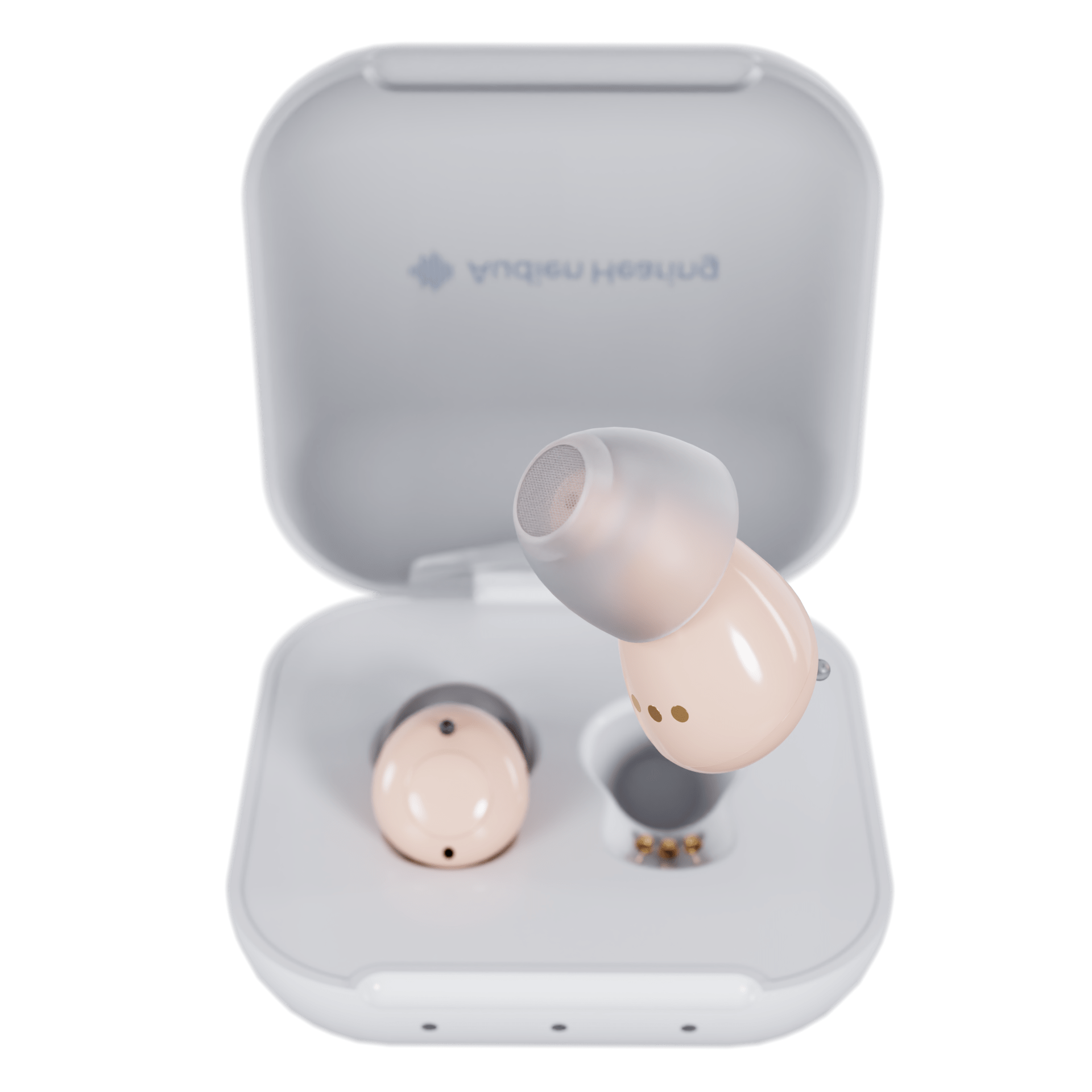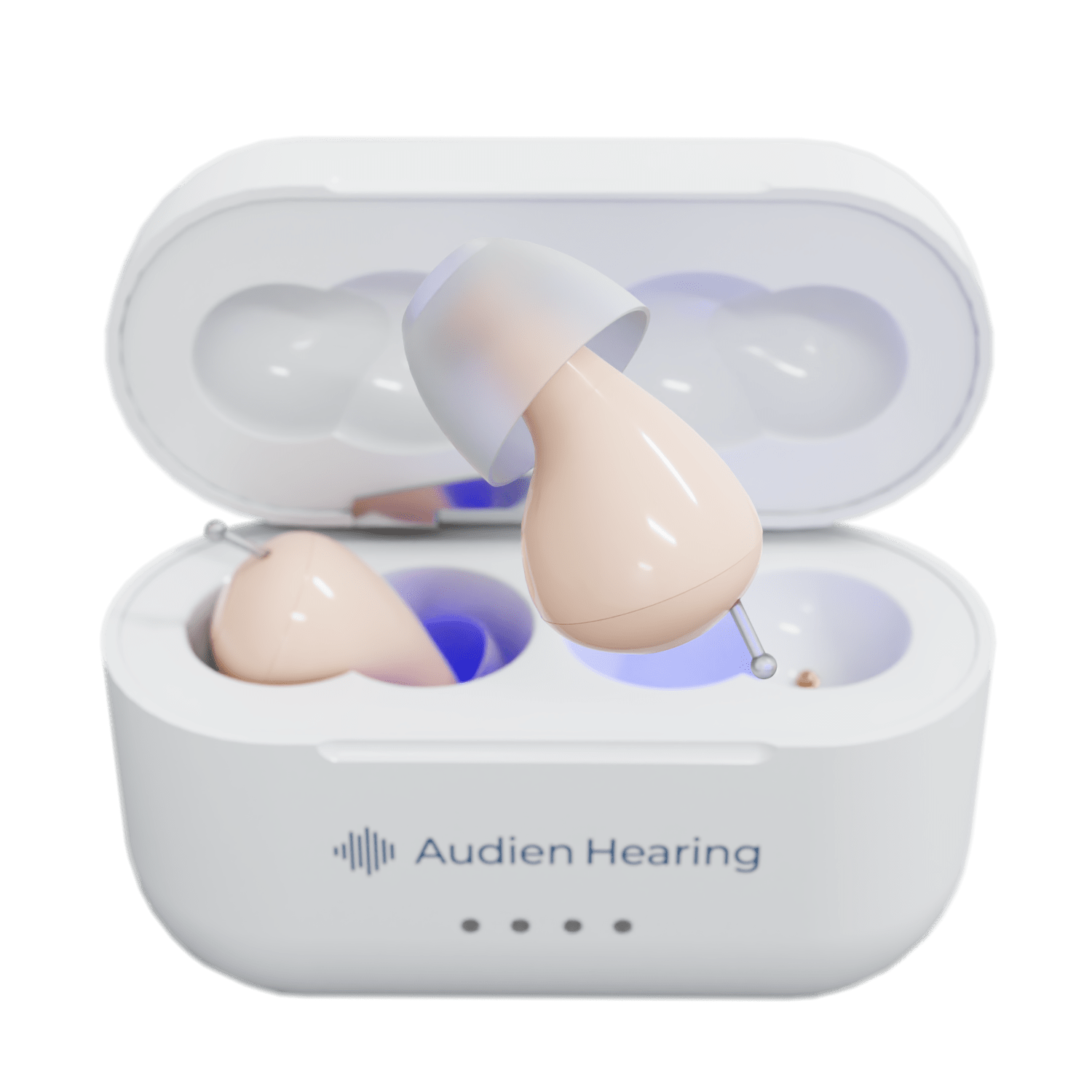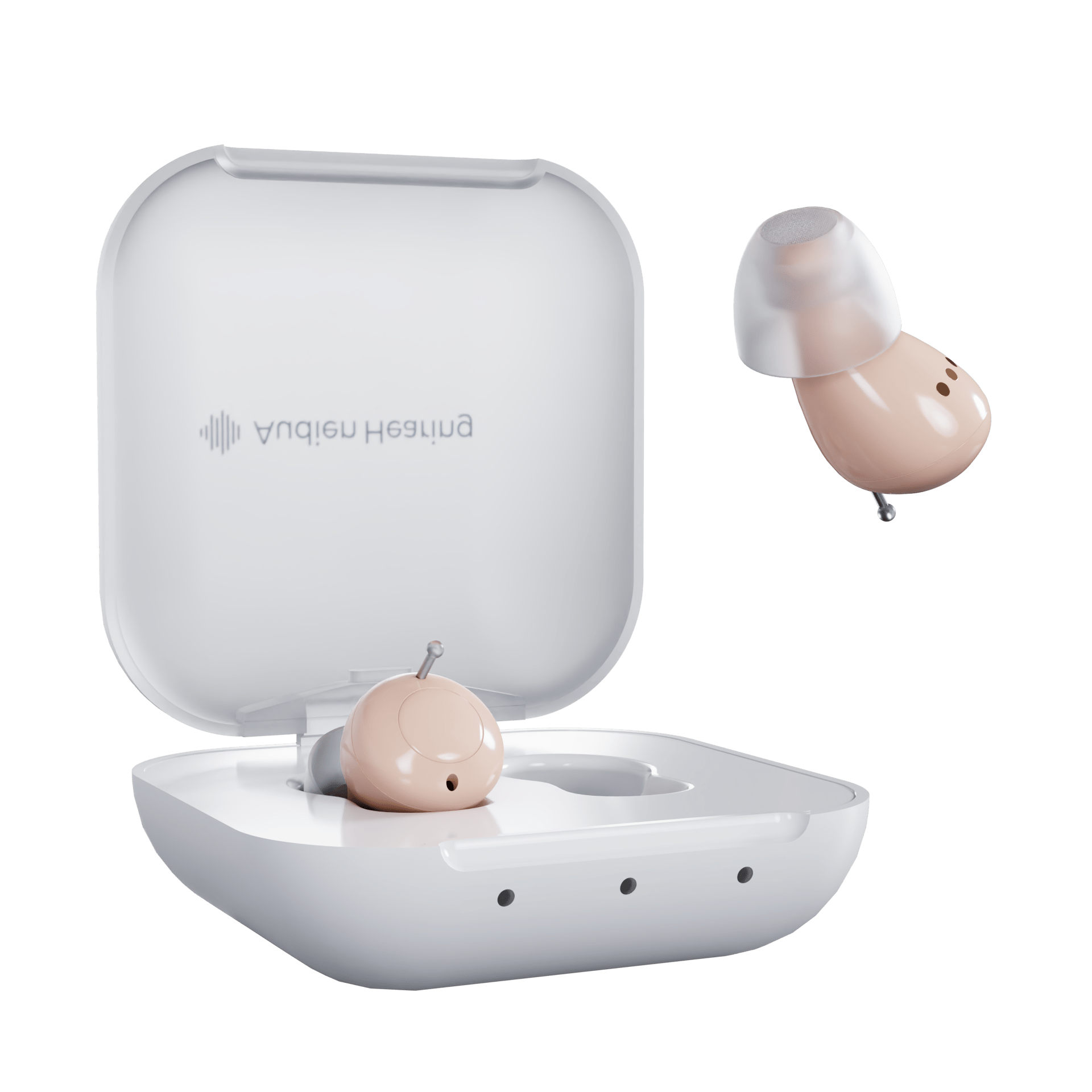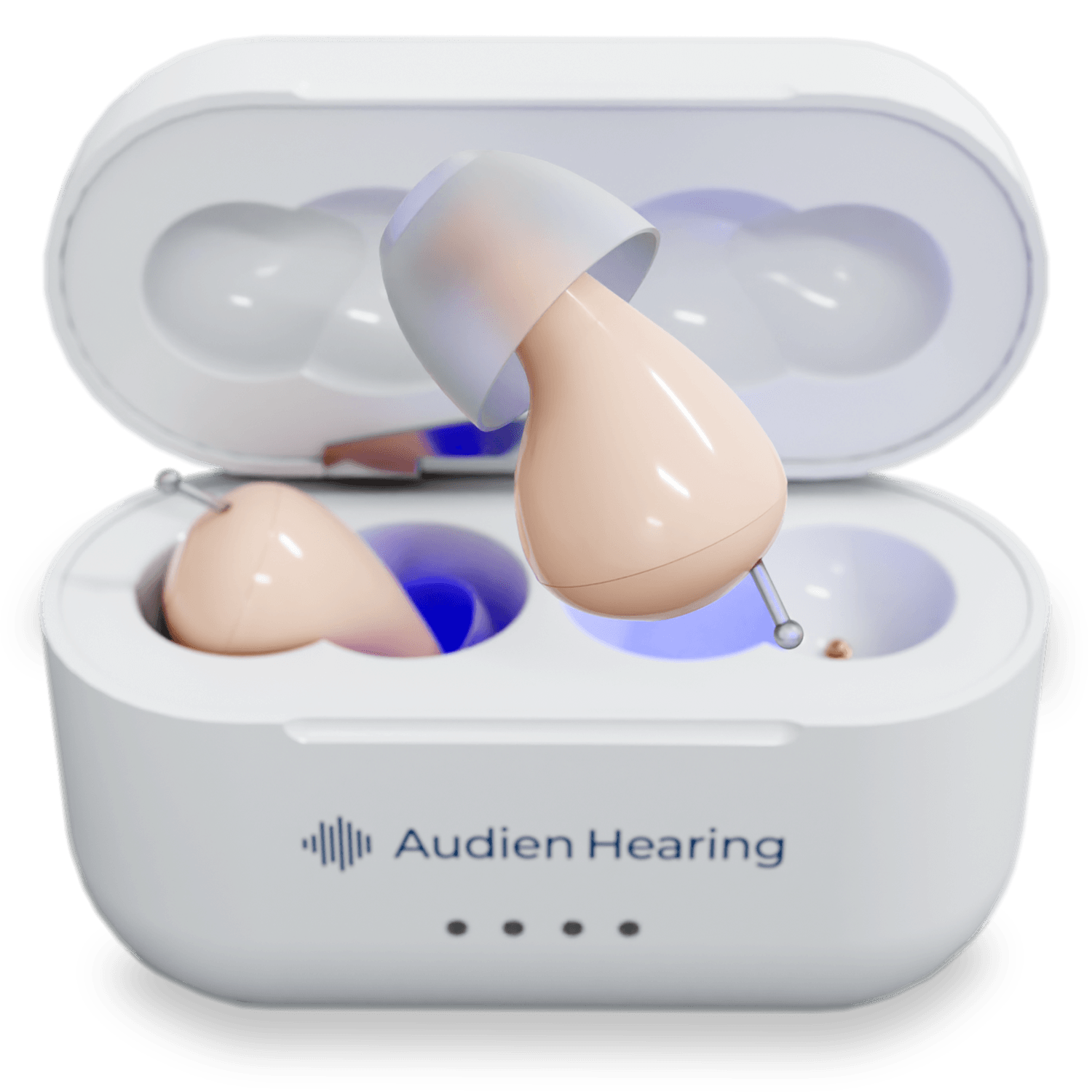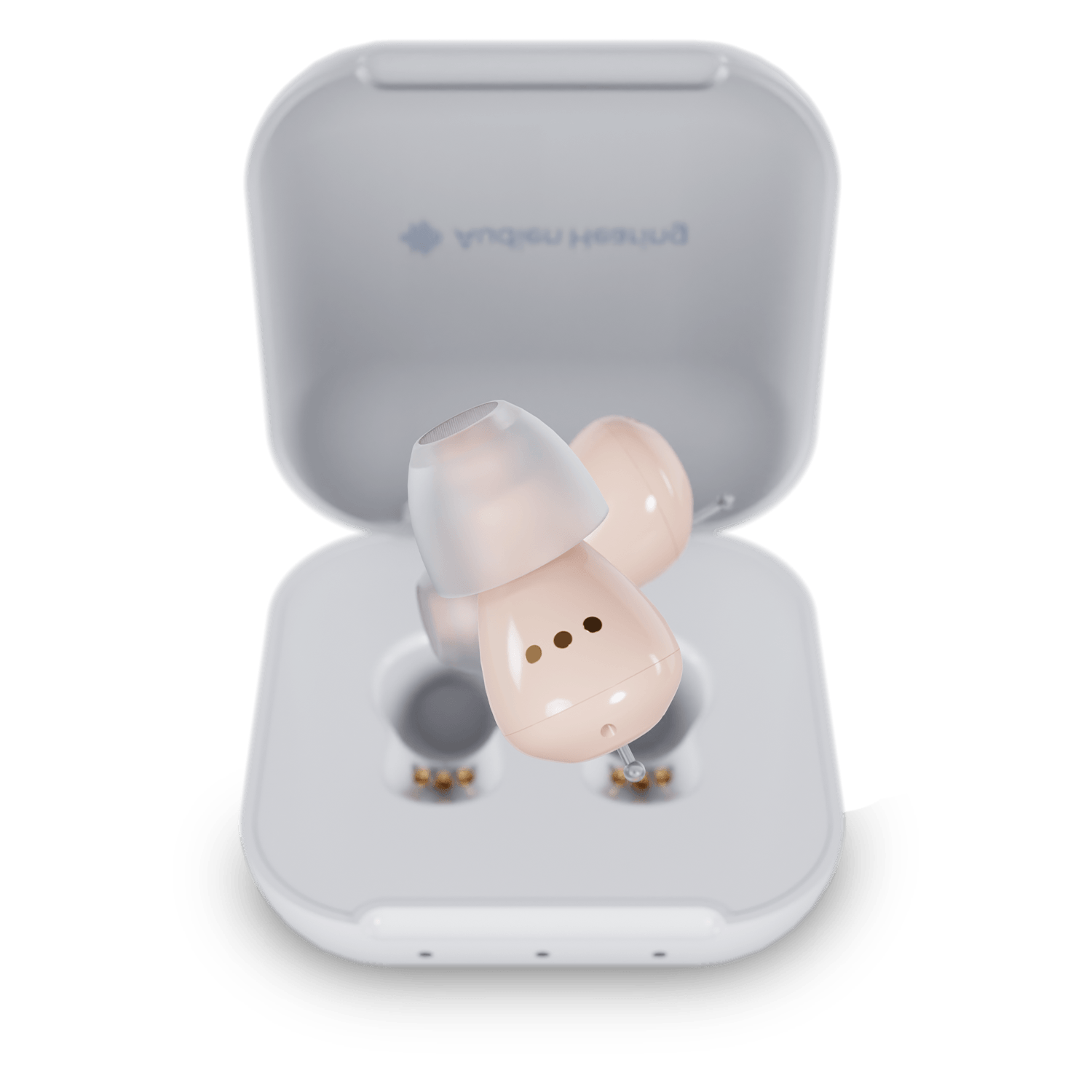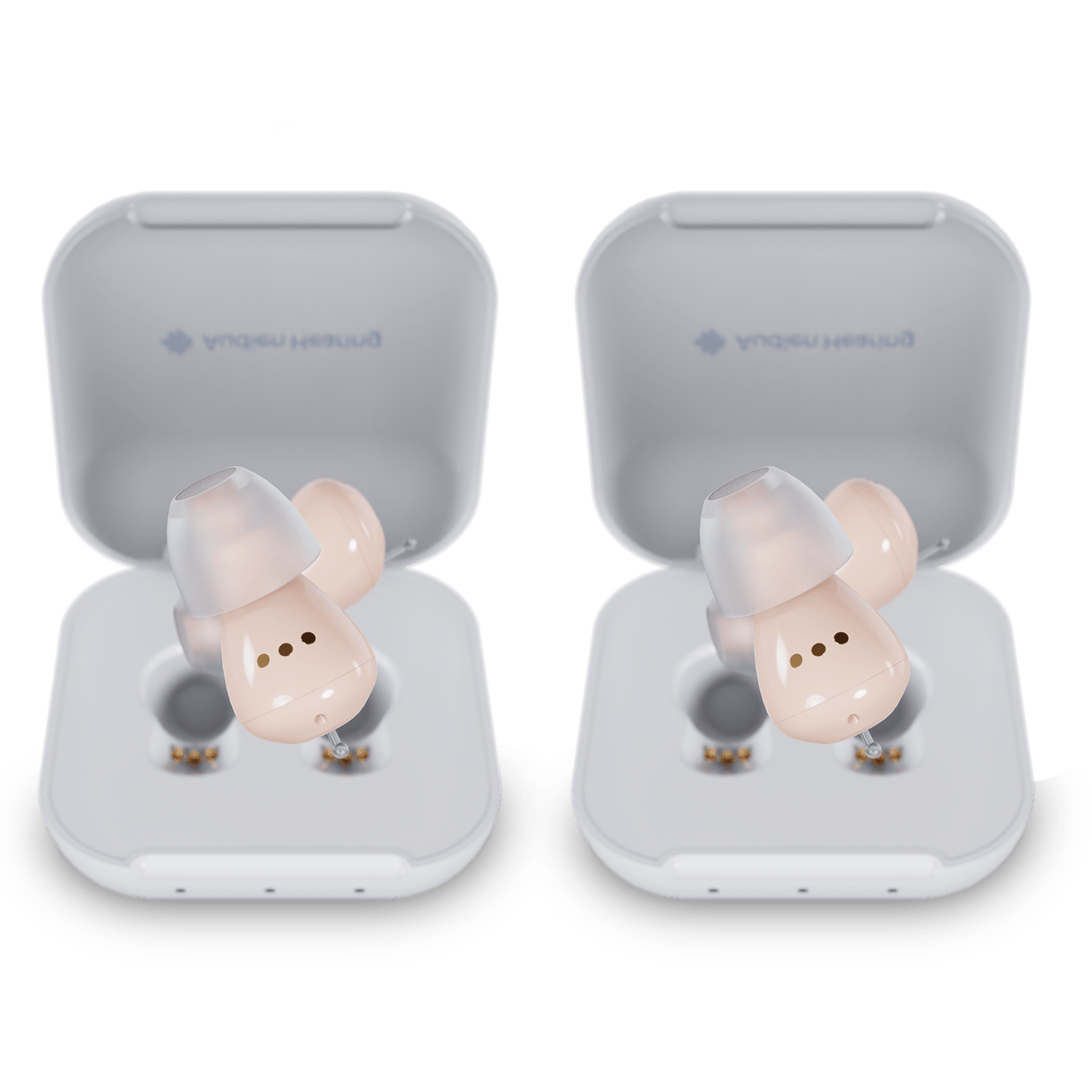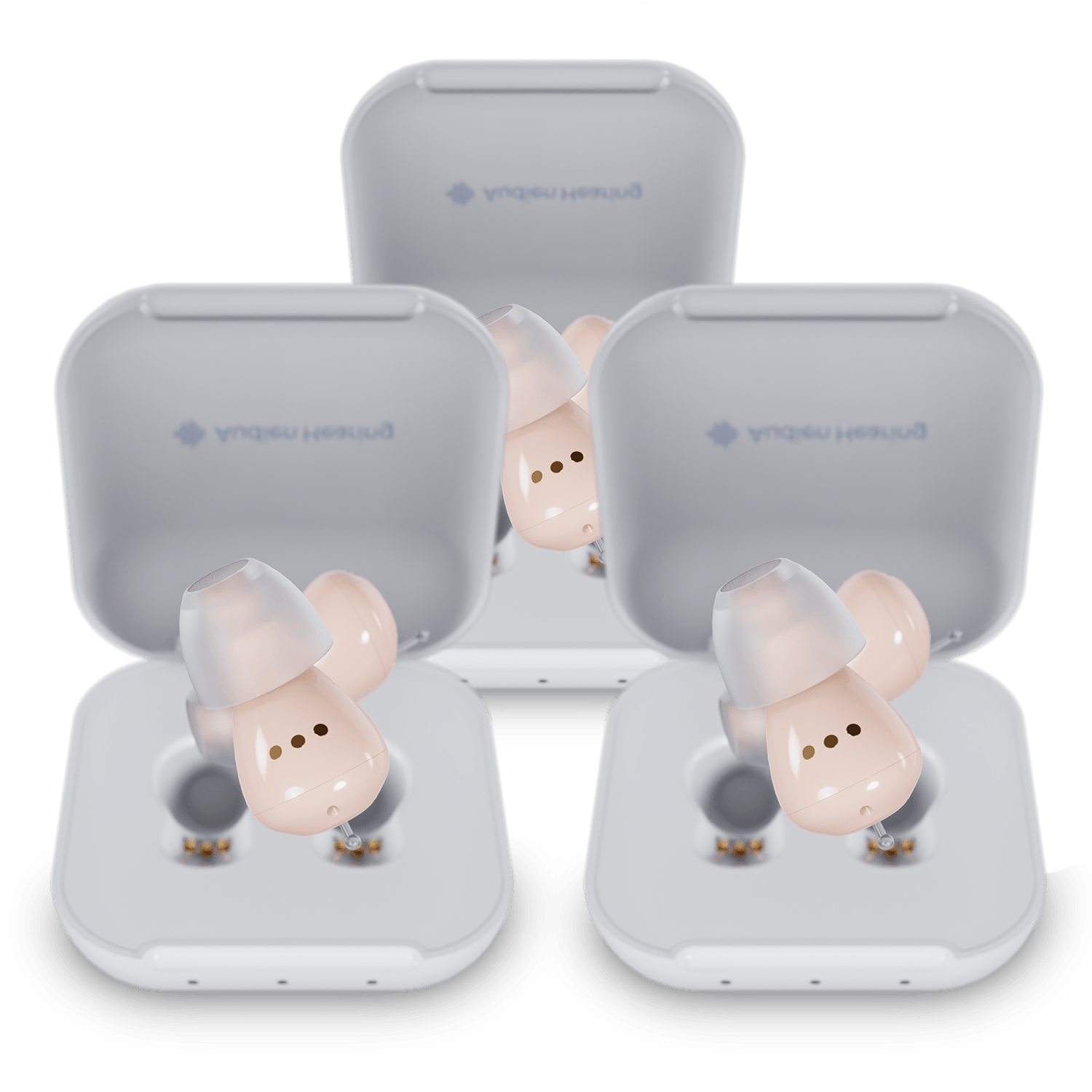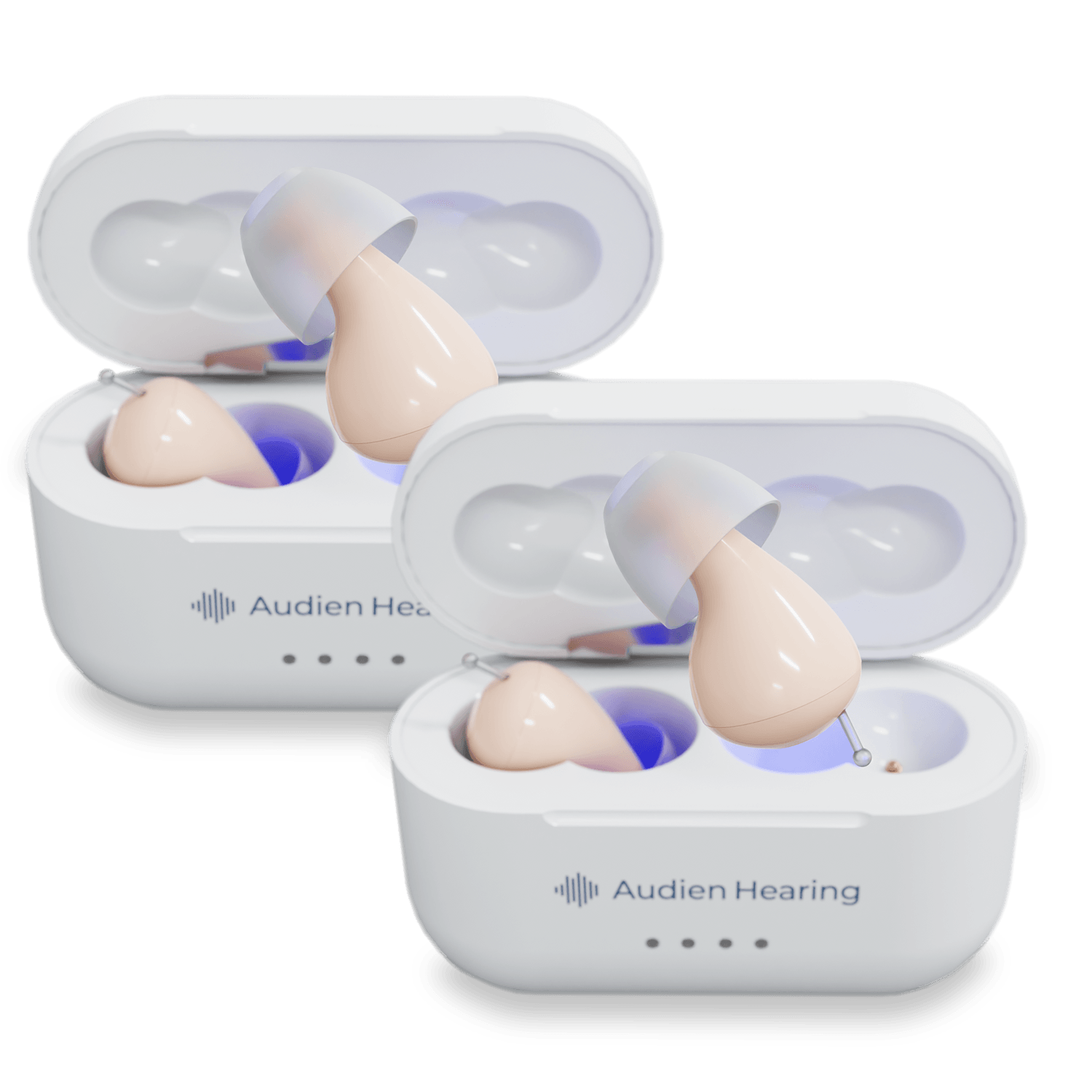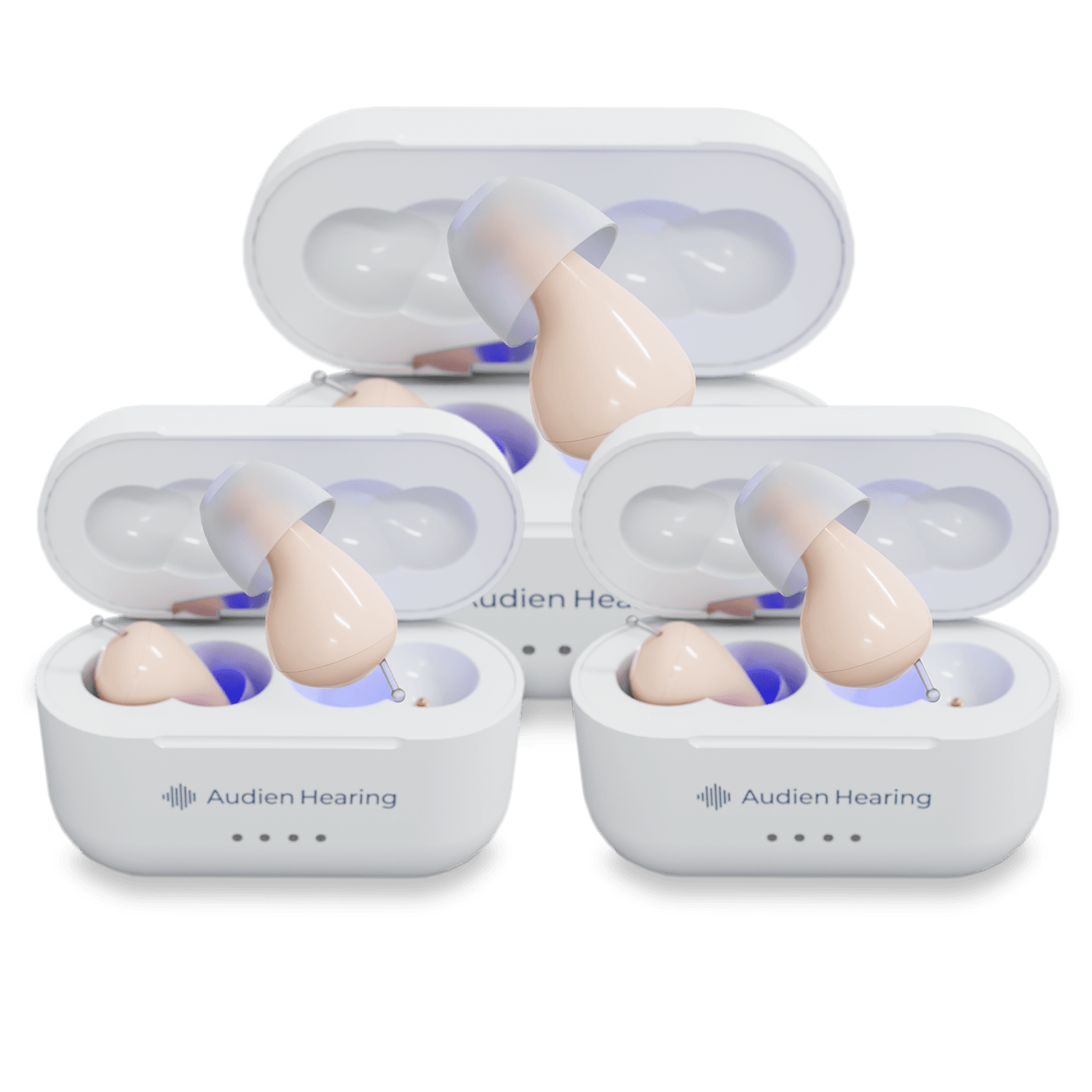Untreated hearing loss can make it difficult to follow conversations, enjoy your favorite shows, or hear the sounds of everyday life. But there are so many solutions available today - like Signia vs Philips hearing aids.
Both of these brands are considered “prescription-grade” hearing aid manufacturers, meaning you’ll have to work with a licensed audiologist to select, program, and adjust your device. This means you can expect to pay thousands of dollars and spend a lot of time at the clinic.
As you can imagine, that’s a bit much for someone who is just dealing with mild-to-moderate hearing loss, which is the case for most people who report hearing loss issues. In these instances, it might make more sense to buy hearing aids online from Audien Hearing instead.
We make high-quality OTC hearing aids designed for those with perceived mild-to-moderate hearing loss (best OTC hearing aids), with devices starting at just $98. You get the key functionality you need to hear clearly and stay connected, without the hassle of in-person clinic visits. Your device is ready to use out of the box.
Learn more about Signia vs Philips hearing aids below, and how Audien Hearing bridges the gap for those who don’t need prescription-grade support!
Sneak Peek at Signia vs Philips Hearing Aids (and Audien Hearing)
|
Factor |
Signia |
Philips (HearLink) |
Audien Hearing |
|
Channel |
Prescription by audiologists |
Costco + audiologist clinics |
OTC (buy online today) |
|
Intended Use |
Mild to profound hearing loss with custom fitting |
Mild to severe (model dependent); warehouse-clinic fit |
Adults with perceived mild–to–moderate loss |
|
Primary Styles |
RIC, BTE, custom (ITE/ITC/CIC), slim RIC |
RIC, BTE; custom options via clinics |
CIC (in-canal) and BTE, discreet fits |
|
Core Tech Focus |
Integrated Xperience, multi-speaker tracking, Own Voice Processing |
AI speech-in-noise, SoundProtect/SoundGuide, LE Audio support |
Speech-first amplification, noise/feedback reduction; A2™ Max chip in Atom X |
|
Controls |
On-device + mobile app (Signia app/Assistant) |
On-device + HearLink 2 app; remote adjustments |
On-device controls; touchscreen case on Atom X; app connectivity |
|
Streaming |
Direct iOS/Android streaming; accessory ecosystem |
Bluetooth LE Audio; hands-free calling on supported phones |
Universal Bluetooth on select models (Ion Pro, Atom X) |
|
Typical Battery/Runtime |
All-day per charge (model/streaming use dependent) |
Up to ~20 hrs per charge (model dependent) + quick charge |
Up to ~48+ hrs total with case (model dependent) |
|
Setup & Support |
In-clinic testing, fitting, follow-ups |
Warehouse clinic fitting; app support |
Ready out of box; lifetime customer support; 45-day risk-free trial |
|
Typical Price (pair) |
≈ $3,000–$7,500+ (technology tier + clinic package) |
≈ $1,600–$3,500 (model/region varies) |
≈ $98–$589 (model dependent) |
Philips Hearing Aids: Models, Pros, and Cons
Philips hearing aids, produced under Demant Group (the same parent company as Oticon), are distributed primarily through Costco hearing centers in the US and select clinics internationally.
The brand has a ton of different devices, but the common theme across the lineup is comfort, value, and accessibility - bridging the gap between high-end prescription devices and consumer-friendly options.
Popular Models
- Philips HearLink 9050: The latest flagship at Costco. Rechargeable RIC model with LE Audio, Bluetooth hands-free calling, and SoundGuide adaptive processing.
- Philips HearLink 9040: Slightly older generation, still widely used in BTE and RIC styles; features SoundProtect for wind and handling noise reduction.
- Custom ITE/ITC/CIC Models: Smaller, clinic-dispensed options for those who need a discreet fit and less reliance on external accessories.
Strengths of Philips Hearing Aids
Philips does a really good job leveraging AI-driven sound enhancement through its SoundGuide and SoundProtect systems, which identify speech and suppress unwanted noise automatically.
The brand also incorporates Bluetooth LE Audio and compatibility across iPhone and Android devices in its HearLink 9050 device. You get hands-free calling, too, which is usually only available through higher-end devices.
You can effortlessly control hearing aid settings through the HearLink 2 app, while the Charger Plus offers multiple full recharges for travel convenience. But, some users look at this as a flaw rather than a strength as they don’t want to deal with yet another app just to hear better.
Cost and Accessibility
You’ll likely go through a Costco hearing center to get a Philips device, and it’ll probably run you between $1,600 and $3,500 per pair based on configuration and service package. That’s more affordable than most clinic-only options while still offering high-end technology.
Just be aware, Costco fittings don’t always provide the same level of personalization or ongoing care found in full audiology practices. It’s more than enough (if not overkill) for those with mild-to-moderate loss who prefer to skip appointments and complex app setups, though.
Signia Hearing Aids: Models, Pros, and Cons
Signia is a brand under WS Audiology, a leading manufacturer in the hearing aid industry. Its designs consistently blend advanced digital processing with user-friendly comfort for people across the full spectrum of hearing loss, from mild to profound.
Popular Models
- Pure Charge&Go IX: RIC (receiver-in-canal) model using Signia’s Integrated Xperience platform (IX) with RealTime Conversation Enhancement and Own Voice Processing for clear speech in noise.
- Styletto IX: Slim RIC design focused on aesthetics and portability, with a portable charger and modern styling.
- Silk Charge&Go IX: One of the smallest rechargeable CIC hearing aids available; instant-fit silicone sleeves eliminate the need for custom molds.
- Motion Charge&Go IX: A BTE (behind-the-ear) solution for those with severe to profound loss, featuring long battery life and robust output.
Strengths of Signia Hearing Aids
Signia’s Integrated Xperience platform is a major selling point. It analyzes multiple speakers in real time to help you keep up in dynamic, noisy environments like restaurants or group settings. Select hearing aids also have Own Voice Processing (OVP) which makes your own speech sound more natural, too.
The Signia Assistant app uses AI to fine-tune sound automatically so you don’t always have to make an appointment with your audiologist to adjust the device. Many models support direct Bluetooth streaming to iOS and Android devices and offer portable charging options for travel.
Cost and Accessibility
These hearing aids are sold exclusively through audiologists or hearing clinics. They’re not available online. Prices vary widely based on configuration and local service packages, generally ranging from $3,000 to $7,000 per pair.
That cost can be traced back to the professional fitting process and premium-level technology you’re getting, and it could be worth it if you need advanced customization for your unique hearing profile. Otherwise, it’ll be a bit excessive - especially for mild-to-moderate hearing loss.
Our blog has more resources comparing Phonak vs Signia or Oticon vs Signia if you want to weigh other options. But for now, let’s take a closer look at Signia vs Philips hearing aids below.
Signia vs Philips Hearing Aids: Which Brand is Right For You?
It’s clear that both of these brands are built on strong engineering pedigrees - Signia under WS Audiology and Philips under Demant. That means either of these options can be a capable solution for your hearing loss.
But while their technology seems similar on paper, their design philosophies, pricing, and user experience are different enough to warrant a closer look. Here’s what you need to know about Signia vs Philips hearing aids.
Comparison of Core Technologies
Signia’s IX platform continuously analyzes multiple speakers and adapts its directional microphones within milliseconds so you can hone in on the exact voice you want to hear. That’s what makes these devices so powerful in group settings or busy environments.
On the other hand, Philips relies on SoundGuide and SoundProtect AI processing to identify speech patterns and automatically suppress wind, impact, and handling noise. Some people who have tried both say this experience feels smoother with less manual adjustment needed.
However, we’ve also heard that Philips’ devices can sound slightly softer or less “sharp” than Signia’s tuning. Philips also supports Bluetooth LE Audio for modern wireless streaming, while Signia currently integrates LE Audio selectively in newer IX models.
Style, Comfort, and Design Differences
One of the biggest differences between Signia vs Philips hearing aids actually has less to do with performance and more to do with aesthetics and how the devices feel to wear all day.
Signia’s hearing aids lean a bit more modern and fashion-forward. The Styletto IX and Silk Charge&Go IX lines are particularly sleek for those who want to keep things discreet. They’re more like a consumer tech product than a medical device.
In contrast, Philips designs are more traditional. Its HearLink RIC and BTE models are made for long-term comfort and durability rather than looks. This can actually be a good thing, though, as slim ITE devices aren’t ideal for everyone. Philips are easier to control and more comfortable.
Connectivity and Apps
Your hearing aid shouldn’t live in isolation - it should integrate with every aspect of your life. Fortunately, both of these brands incorporate Bluetooth streaming across their devices. You can take calls, listen to music, or stream audio directly to both ears.
Signia’s mobile ecosystem revolves around the Signia app and its built-in Signia Assistant. This AI-based tool lets you make personalized sound adjustments without visiting your audiologist, so you can feel a bit more independent.
Further to that point, the app integrates remote fine-tuning, sound environment detection, and detailed control over directionality. It’s great for tech-savvy users - but maybe a little overwhelming for those who aren’t so comfortable with technology.
Philips takes a simpler approach with its HearLink 2 app. You get quick access to volume, program changes, and sound focus without advanced tuning layers. It also supports remote adjustments by professionals, which is convenient for Costco users who want aftercare without another trip back to the store.
Service Network and Distribution
Where you’ll go to get fitted for a device and have it programmed varies, too.
Signia devices are available exclusively through licensed audiologists and hearing clinics. Each fitting comes with comprehensive testing, calibration, and in-person adjustments. This allows for a better fit, but comes with a higher time and cost commitment.
Philips hearing aids are often seen as more accessible because they’re sold primarily through Costco’s hearing centers, where you’ll gain access to in-store hearing tests and fittings at a lower price point. It’s more efficient - IF you have a Costco hearing center in your city.
While both approaches offer professional-grade care, they may not be ideal for those with mild-moderate hearing loss and prefer a simpler, ready-to-use solution. That’s where an OTC option like Audien Hearing could make more sense.
Cost Per Device
Both Signia and Philips produce prescription-grade hearing aids that are professionally fitted and programmed by licensed providers. However, Signia does tend to be the most expensive option:
- Signia: $3,000-$7,000 per pair
- Philips: $1,600-$3,500 per pair
Insurance coverage for hearing aids varies widely, but most plans do not cover the full cost of prescription-grade devices. Fortunately, you aren’t limited to just these options. There are smarter solutions online at Audien Hearing.
How Audien Hearing Supports Those With Mild-to-Moderate Hearing Loss
Choosing between Signia vs Philips hearing aids makes sense if you’re struggling with profound hearing loss and want the audiologist support these devices come with - and you have the budget to spend thousands of dollars.
But what if you’re just looking for support for mild-to-moderate hearing loss? These prescription-grade devices would probably be overkill for you. Our stylish hearing aids at Audien Hearing are likely a better fit.
Our customers are often first-time hearing aid users who simply want to hear conversations clearly again, follow TV dialogue, or stop asking others to repeat themselves. Every product we design is built to deliver that support easily and affordably, right out of the box.
- Atom One: Our entry-level model at $98. A small, ITE design with rechargeable convenience for those who want clear amplification for everyday listening without extra setup or features.
- Atom Pro 2: For users who wear their hearing aids all day, the Pro 2 adds a UV-cleaning charging case that sanitizes between uses and a refined sound processor that better handles background noise. You get 4 distinct hearing modes.
- Ion Pro: This BTE model uses directional microphones and extended battery life to support users who prefer a secure fit and stronger sound clarity. It’s also ideal for those who want Bluetooth streaming and app controls. You get 6 hearing modes.
- Atom X: Our most advanced model, featuring CaseControl™ touchscreen technology to adjust volume, hearing modes, and Bluetooth streaming directly from the case - no apps, small buttons, or frustration.
Every Audien device includes free lifetime customer support, a 45-day money-back guarantee, and hassle-free replacement options. Get in touch today to find out if our devices are the right fit for your needs!
Audien Hearing devices are intended for adults with perceived mild-to-moderate hearing loss and are not substitutes for professional hearing care. If you experience sudden or severe hearing loss, tinnitus, or medical ear symptoms, please consult a licensed provider.
Parting Thoughts on Signia vs Philips Hearing Aids
Both sides of the Signia vs Philips hearing aids debate deliver excellent hearing technology for people who need professional fittings and advanced clinical features. But they’re not necessarily the optimal solution for mild-to-moderate hearing loss.
Learn more about Signia vs Jabra hearing aids or Signia vs Widex hearing aids in our blog if you’d like - but at the end of the day, any prescription-grade manufacturer is likely more performance than you need for mild-to-moderate hearing loss. They cost more than it makes sense to pay for your unique hearing profile. Audien Hearing could be a smarter solution.
Whether you need the best hearing aids under $200 or the best hearing aid under $100, there’s a device in our lineup that could fit your needs. Experience clear, effortless hearing at home with Audien Hearing’s OTC hearing aids today!
